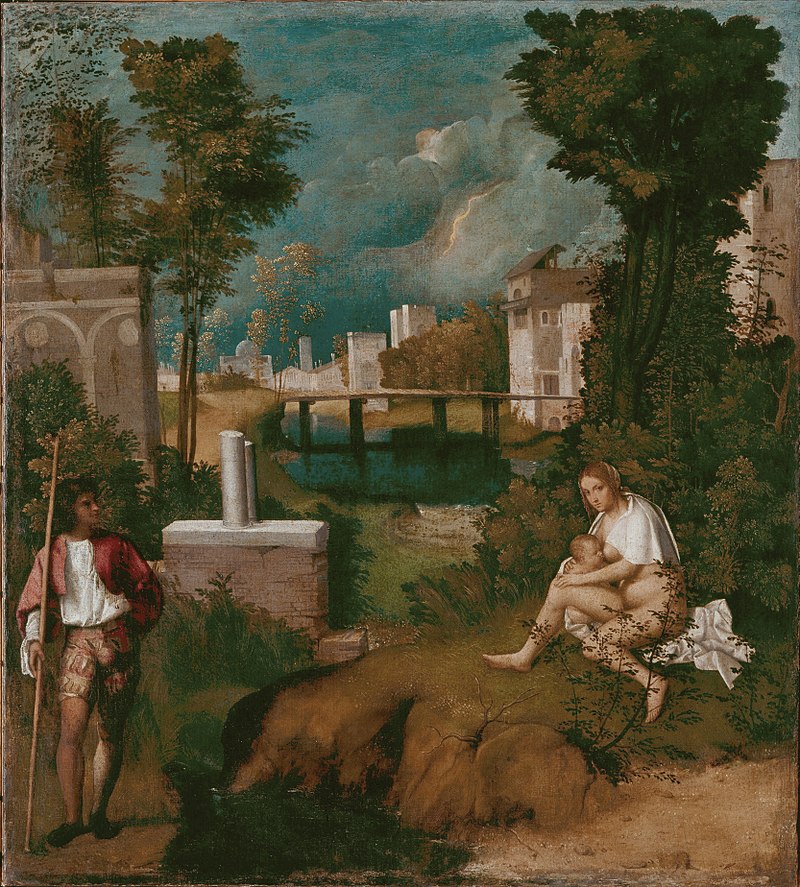by Pedro Blas González (February 2025)

He knew he had no gift for painting, but even so he wanted to believe he would live on in the memory of his contemporaries with works comparable with those of the great masters, whom he had judged with great critical insight. But critical insight seldom goes together with creative talent. —Juan Manuel de Prada, The Tempest
Juan Manuel de Prada, The Tempest

The most poignant and impactful works of art, literature, and philosophy man has produced recognize and remind thoughtful people that life is the greatest protagonist. Novelist Anthony Burgess is correct that “to engage literature one has first to engage life.” Until our late postmodern culture of death understands and respects this truth, our age will never again realize the importance of nuanced narrative in art, literature, and philosophy.
It is an understatement to say that Juan Manuel de Prada’s novel The Tempest is a multidimensional work: noir, detective novel, adventure story. The thorny situations and out-there characters of the novel speak to that. The Spanish author’s novel revolves around Giorgione’s suggestive High Renaissance painting The Tempest.
The Tempest begins with an exploration of Giorgione’s enigmatic painting. Giorgione’s painting intrigues Alejandro Ballesteros. It is the reason for his visit to Venice. Ballesteros, a young art history research fellow at a Spanish university arrives in Venice to meet with the director of the Academia, where The Tempest is housed.
A leading figure in the literature of the Spanish speaking world, de Prada has become a respected novelist for his linguistic flair, lyricism and mastery of style. Reacting to the moral, spiritual and cultural austerity, and poverty of late postmodern fiction and literature, de Prada refers to his writing as baroque. He considers himself heir to the baroque and lyrical writers that Spain has produced: Lope de Vega, Francisco de Quevedo and Calderon de la Barca, to name a few. Regrettably, of his over fifteen published novels and non-fiction books only The Tempest has been translated into English. This is shameful, considering the unending stream of formulaic fodder that populates the English language bestseller list.
Once he arrives at his small hotel in Venice, Ballesteros witnesses a murder. The murdered art forger is Fabio Valenzin. This is the beginning of a convoluted plot, which culminates in Ballesteros’ disillusionment with the art world and the political mechanizations and intrigues of Venice’s underworld. The murdered man is a skilled art forger known to local police.
The Tempest takes readers on a romp through crime fiction, the murky world of art forgery and the shady, colorful personages that colonize that world: forgers, manipulative dealers, museums with two-tier moral and professional standards, and crooked private collectors. None of them escape de Prada’s criticism of their double dealing and virtue signaling corruption. The Spanish author reaps great enjoyment doing so.
Besides providing readers with reading pleasure and enlightenment, the work of intellectually honest writers should unmask hypocrisy and affectation, in addition to reminding us that ‘all is vanity.’ Not that doing so will make a dent in the crooked timber that is man, but truth must be made manifest, nonetheless.
Some of the prominent themes of The Tempest include: artificiality of the art world, maniacal museum curators, cannibalizing collectors, the naive romance of the inexperienced Ballesteros with the art world and murder for profit. The plot mechanism of The Tempest resembles Eric Ambler’s A Coffin for Dimitrios, where an unsuspecting, though meddlesome writer, becomes entangled in the murder of an underworld character.
Labyrinthian plots that twist and meander, creating a maze of appearances, while interlacing reality and unreality, is the meat and potatoes of the novel of intrigue. Fine examples of this genre are Umberto Eco’s The Name of the Rose, where Aristotle’s Poetics is the source of the intrigue and Foucault’s Pendulum, where Eco makes a fake secret society the focus of the novel.
Another truly masterful novel of detection and historical duplicity is Anthony Burgess’, author of the A Clockwork Orange, A Dead Man in Deptford. This novel explores arresting aspects of the tortured life and sexual obseessions of British writer and playwright Christopher Marlowe.
John Creasey, The Baron & the Missing Old Masters
 John Creasey’s striking character, Baron John Mannering, is sheer reading pleasure. The Baron is an art expert who is routinely consulted by people who want to assess the value of their paintings and other works of art. The Baron is a likeable, down to earth bon vivant who guides readers through a rabbit warren of conspiracies, machinations, and connivance.
John Creasey’s striking character, Baron John Mannering, is sheer reading pleasure. The Baron is an art expert who is routinely consulted by people who want to assess the value of their paintings and other works of art. The Baron is a likeable, down to earth bon vivant who guides readers through a rabbit warren of conspiracies, machinations, and connivance.
The plot of this type of novel is usually involved and tightly woven. This engages the attention of readers, while demanding they sharpen their inductive skills. This is a literary convention that readers of novels of detection quickly warm up to. Plot is one thing, as much as the structure of a novel requires intricate happenings that keep the readers guessing, reading delectation is another.
The most interesting element of Creasey, the writer, as is also true of Georges Simenon, Creasey’s contemporary French writer of romans policiers, is the perspective they take on human behavior, choice-making, and morality. In one way or other, human nature is the protagonist of Creasey’s novels.
In The Baron & the Missing Old Masters, the Baron takes on several cut-throat criminals who double as art forgers. Baron Mannering suspects much but manages to keep his knowledge of the goings-on to himself, as not to give his position away … all in due time. This is a staple of the detective novel. The main thing is to weigh the clues that the Baron, and readers alike, cling to. In other words, what is the moral or amoral motivation, as the case may be, that fuels criminals?
G.K. Chesterton’s’ Father Brown detective stories are the par excellence measure of this form of detection. Chesterton’s slippery criminal Hercule Flambeau appears in 48 Father Brown short stories. While Conan Doyle and Agatha Christie focus on induction and deduction, that is, chess-game, detecting prowess put on display, Chesterton delves into the moral and spiritual world of criminals, making him a fitting exposer of the normalized moral and spiritual dysfunctionality of late postmodern man.
The Tempest and The Baron and the Missing Old Masters are evocative of the successful real-life art folder, Elmyr de Hory, whose story vividly comes to life in Clifford Irving’s book Fake! Irving’s book was made into one of Orson Welles’ best films F For Fake in 1973. De Prada’s character, Ballesteros, the art historian, makes reference to Elmyr de Hory in The Tempest. This sets up an elaborate salad of reality-unreality, where art-imitates-life-imitating-art.
A policeman tells Ballesteros, “An art expert like you should know all the most famous forgers.” Ballesteros responds: “It’s not a subject they teach us in the university.” He is apologetic about his ignorance, but goes on to say, “I know about the Hungarian Elmyr de Hory from the film Orson Welles made about him, and a Dutchman who forged Vermeer’s, back in the forties.” The expert forger Dutchman he refers to is Han van Meegeren, who fooled many art experts and historians into believing that his forged works are originals.
In Irving’s book and Welles’ film, de Hory explicitly explains his technique for forging paintings, Modigliani and Matisse being his most prodigious. Consider de Hory’s rationale and approach. He explains: “With Matisse, for example, I had to be particularly careful. At the beginning – say, around 1948 – I used a very easy, flowing line for a Matisse drawing. Because he had, I thought, a very simple line. And then suddenly later on I realized that his hand was not as secure as mine. Obviously, when he stopped work to glance up at his model, his line stopped, too, with just that tiny little bit of uncertainty. Where I went very securely on, Matisse was hesitant, insecure. I had to correct that; I had to learn to hesitate also.”
Arturo Pérez-Reverte, The Club Dumas
 Like de Prada, Arturo Perez-Reverte’s novels are translated into English. The Club Dumas is a work about literature and pirated rare book editions. The centerpiece of the novel is the flamboyant Alexandre Dumas, writer of The Three Musketeers and The Count of Monte Cristo.
Like de Prada, Arturo Perez-Reverte’s novels are translated into English. The Club Dumas is a work about literature and pirated rare book editions. The centerpiece of the novel is the flamboyant Alexandre Dumas, writer of The Three Musketeers and The Count of Monte Cristo.
Lucas Corso, the protagonist of The Club Dumas, is a connoisseur of rare books. He is hired by book collectors to find and purchase rare books and manuscripts from other collectors. Corso is hired to authenticate an alleged original manuscript of Dumas’ The Three Musketeers that has surfaced on the market. The manuscript’s owner is a well-known bibliophile who has allegedly committed suicide.
The plot of The Club Dumas is intricate, knotty. Frankly, what makes this book and others of its kind satisfying reading is the pleasure readers take from trying to figure out the backdrop of the plot. Does the backdrop not become part of the plot? To an extent, yes. Without it, the plot of books that dive deep into literary and philosophical nuance would lack their literary gallantry.
The absence of nuanced narrative and lyricism is one contributing reason to the sterility and austerity of bestsellers, cinema, television, and even daily life in late postmodernity, whether artistic, literary, philosophical, etc.
Imagination in literature begets imagination in readers; at least, it demands it. Literature sets up literary and philosophical parameters that have for time immemorial distinguished the curiosity of readers from nonreaders. Self-serving critics who propose that cinema has taken the place of literature and reading for late-postmodern man confuse canned meat with caviar. These critics should have their heads examined, in addition to engaging in soul-searching self-reflection that can lead to intellectual honesty and integrity.
The backstory of The Club Dumas surrounds the idea that Alexandre Dumas was a gifted writer who saw himself as embodying the role of showman. Dumas’ critics accuse the writer of embellishing history, indeed lying about the historical sources of his characters. Dumas and his ghost writer August Maquet took liberties with historical facts. Yet, the result is of literary value, not history. When asked about the historical accuracy of his novels, Dumas responded: “True, I have raped History, but it has produced some beautiful offspring.”
The real life ‘three musketeers’ were men who did not know each other or didn’t even exist. Real life Comte d’ Artagnan, Charles de Batz de Castelmore, would not recognize himself as a character in The Three Musketeers. That is not important to novelists. What real people served as inspiration for the characters Aramis, Porthos, Athos, and Milady de Winter? Incidentally, Umberto Eco makes Alexandre Dumas a character in The Prague Cometary.
The Three Musketeers appeared in print in installments in Le Siècle from March to July 1844. What became of the original manuscripts once they were typeset? This opens the door to forgery.
Finding a complete manuscript of The Three Musketeers is the motivation that fuels The Club Dumas, its scheming and sinister re-enactments that culminate in murder. This is the backdrop that animates Perez-Reverte’s plot, a murder mystery perpetrated by rare book bibliophiles.
For this bibliophile, who writes about fiction, literature, books and reading, human reality, its grandeur, frivolity, and misery serves as the operating manual that makes books, literature and philosophy man’s supreme human creation. Human life and reality are indeed the greatest protagonists in art, literature and philosophy; a timeless lesson that late postmodern man must learn.
Table of Contents
Pedro Blas González is Professor of Philosophy in Florida. He earned his doctoral degree in Philosophy at DePaul University in 1995. Dr. González has published extensively on leading Spanish philosophers, such as Ortega y Gasset and Unamuno. His books have included Unamuno: A Lyrical Essay, Ortega’s ‘Revolt of the Masses’ and the Triumph of the New Man, Fragments: Essays in Subjectivity, Individuality and Autonomy and Human Existence as Radical Reality: Ortega’s Philosophy of Subjectivity. He also published a translation and introduction of José Ortega y Gasset’s last work to appear in English, “Medio siglo de Filosofia” (1951) in Philosophy Today Vol. 42 Issue 2 (Summer 1998). His most recent book is Philosophical Perspective on Cinema.
Follow NER on Twitter @NERIconoclast
- Like
- Digg
- Del
- Tumblr
- VKontakte
- Buffer
- Love This
- Odnoklassniki
- Meneame
- Blogger
- Amazon
- Yahoo Mail
- Gmail
- AOL
- Newsvine
- HackerNews
- Evernote
- MySpace
- Mail.ru
- Viadeo
- Line
- Comments
- Yummly
- SMS
- Viber
- Telegram
- Subscribe
- Skype
- Facebook Messenger
- Kakao
- LiveJournal
- Yammer
- Edgar
- Fintel
- Mix
- Instapaper
- Copy Link







One Response
Interesting reading.